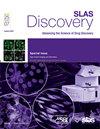用于高通量筛选KCC2调节剂的BRET氯化物生物传感器的研制
IF 2.7
4区 生物学
Q2 BIOCHEMICAL RESEARCH METHODS
引用次数: 0
摘要
神经细胞中动作电位的产生和许多其他生理过程都涉及氯离子的转运。虽然利用FRET生物传感器的氯化物成像技术取得了进展,但缺乏适用于药物发现的高通量筛选的方法。在这项研究中,我们开发了一种新型的基于bret的生物传感器(Glorider),利用氯化物敏感的GFP变体与NanoLuciferase融合。然后使用Glorider生物传感器实时动态测量WNK、KCC2和NKCC1调节剂在活细胞中的作用,包括最近报道的KCC2激动剂。本文章由计算机程序翻译,如有差异,请以英文原文为准。
Development of a BRET based chloride biosensor for high throughput screening of KCC2 modulators
The generation of action potentials in neuronal cells and many other physiological processes involve the transport of chloride ions. Whilst there have been advances in chloride imaging techniques utilizing FRET biosensors, there is a lack of methodologies that are amenable to high-throughput screening for drug discovery. In this study, we developed a novel BRET-based biosensor (Glorider), utilizing a chloride-sensitive GFP variant fused to NanoLuciferase. The Glorider biosensor was then used to kinetically measure the effect of WNK, KCC2 and NKCC1 modulators in real time in living cells, including recently reported KCC2 agonists.
求助全文
通过发布文献求助,成功后即可免费获取论文全文。
去求助
来源期刊

SLAS Discovery
Chemistry-Analytical Chemistry
CiteScore
7.00
自引率
3.20%
发文量
58
审稿时长
39 days
期刊介绍:
Advancing Life Sciences R&D: SLAS Discovery reports how scientists develop and utilize novel technologies and/or approaches to provide and characterize chemical and biological tools to understand and treat human disease.
SLAS Discovery is a peer-reviewed journal that publishes scientific reports that enable and improve target validation, evaluate current drug discovery technologies, provide novel research tools, and incorporate research approaches that enhance depth of knowledge and drug discovery success.
SLAS Discovery emphasizes scientific and technical advances in target identification/validation (including chemical probes, RNA silencing, gene editing technologies); biomarker discovery; assay development; virtual, medium- or high-throughput screening (biochemical and biological, biophysical, phenotypic, toxicological, ADME); lead generation/optimization; chemical biology; and informatics (data analysis, image analysis, statistics, bio- and chemo-informatics). Review articles on target biology, new paradigms in drug discovery and advances in drug discovery technologies.
SLAS Discovery is of particular interest to those involved in analytical chemistry, applied microbiology, automation, biochemistry, bioengineering, biomedical optics, biotechnology, bioinformatics, cell biology, DNA science and technology, genetics, information technology, medicinal chemistry, molecular biology, natural products chemistry, organic chemistry, pharmacology, spectroscopy, and toxicology.
SLAS Discovery is a member of the Committee on Publication Ethics (COPE) and was published previously (1996-2016) as the Journal of Biomolecular Screening (JBS).
 求助内容:
求助内容: 应助结果提醒方式:
应助结果提醒方式:


